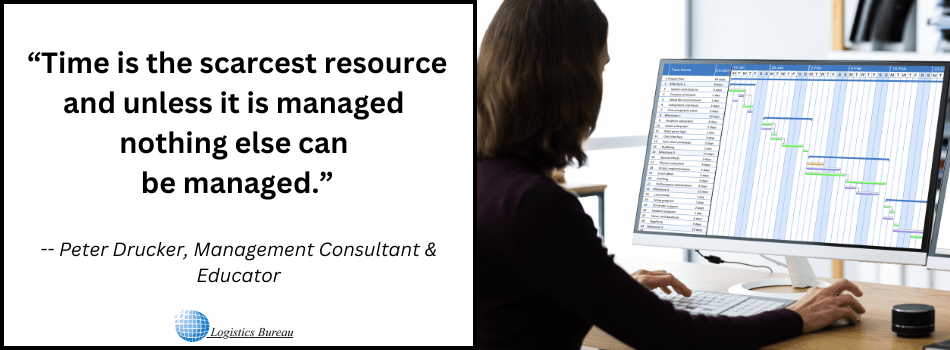Here at Logistics Bureau, project management is second nature, because projects are our day-to-day. And because we are supply chain specialists, well, supply chain projects are our bread and butter.
But in your business, projects are less frequent and must be managed alongside the day-to-day without depriving you of your bread and butter.
Still, if you’re not a project management specialist, don’t worry. You don’t need a PM background to plan and complete a supply chain project, whatever its nature.
Many factors in a project’s success, or otherwise, are seeded during the initial stages of preparation. So if you prepare effectively, your chances of completing the project are high.
But what does it take to prepare for managing a supply chain project? A comprehensive step-by-step guide would be a welcome start, indeed. So here it is… Ten steps to successful supply chain project preparation.
Step 1: Business Case and Buy-In
A project is not a project if there is no approved business case. The business case is what gives life to your project. Therefore, getting approval from an accountable executive should be the first step in your project preparation.
Your organisation may be large or complex enough for the business case to go through several levels of bureaucracy. Or it could be small enough that approval of the business case is a verbal “Go ahead!” from your boss. Either way, this first step is not one to skip.
But a sign-off alone merely signifies permission to go ahead. It will probably take a little more to generate motivation and overcome inertia. The will of the primary stakeholders is everything, but do you have it?
You Can’t Get By Without Buy-In
After you receive approval for the business case, it’s time to campaign for buy-in among the leading project stakeholders. It would be best if you only move on to the next steps in project preparation when you sense their enthusiasm for the project is genuine and palpable.
Of course, there is one more essential requisite for any supply chain project to commence—a budget. However, completing the next steps in this guide (2 and 3) is a good idea before seeking budgetary approval.
Step 2: Define What “Project Complete” Actually Means
One of the most common reasons for project failure typically arises at the very beginning of the venture or even before. The author Stephen Covey famously coined the phrase to “start with the end in mind,” but unfortunately, many project management teams, even today, fail to heed that sage advice.
One of the most critical early steps in project preparation is to understand what the specific result of the project should be once complete. Sounds simple, right?
Well, in truth, it is more complex than it appears.
Furthermore, there is a big difference between thinking you know what “project complete” means and knowing for sure. Unfortunately, many projects commence with their managers thinking they understand the ultimate requirements of the project but not categorically knowing.
Don’t Go Off Half-Cocked
Can you define 100% of the requirements of a large supply chain project, in detail, before it kicks off?
The answer is usually “no,” but such projects are commonly, and erroneously, commenced with less than 50% of the requirements defined in detail. Such ambiguity will doom many projects, so you should aim to have at least 80% of the project’s requirements and goals nailed down to specifics before commencement.
Undefined objectives and requirements lead to project scope creep, which, in the worst cases, can obliterate forecast timelines and blow budgets, so clarifying the goals and scope are actions to take seriously.
We’ll talk more about scope in a moment, but for now, consider the first step to be the most critical, defining as many of the project’s goals as possible.
Step 3: Set the Scope in Stone
If all the primary objectives and requirements of your project are set out, agreed upon, written down, and signed off by all the key project stakeholders, you will be off to a better start than many project teams already.
However, to eliminate, or at least significantly reduce, the likelihood of scope creep setting in, you need next to focus directly on that element of the project. Like the objectives, your aim should be to nail the scope down firmly.
Of course, that means identifying every element of the solution that will fall within the project’s scope, but, just as importantly, detailing all known features that will not be in scope. Unfortunately, that is the part that project teams often miss, and it is an omission that can easily lead to… You guessed it… scope creep!
How to Nail Down the Project Scope
It’s impossible to overstate the criticality of detail in this task.
Every iota of information missing from the list of in-scope and out-of-scope deliverables presents an opportunity for the project’s scope to expand during execution.
So involve all key project stakeholders in the scope definition task and provide ample opportunities to highlight and deliberate over deliverables they believe are missing and should be added.
No doubt the task will be painstaking, perhaps requiring several iterations, and the larger the project and the more stakeholders involved, the more time it will consume. Nevertheless, it’s always better to go through the pain at this stage than to have people demanding new deliverables throughout the project’s duration.
Be Prepared to Shrink the Scope if Necessary
Another reason to define the scope of the project as clearly as possible, is related to the next step in the preparation process.
Remember that, at this point, you still need an approved budget, so what if you run into budget constraints when you bid for approval? At least you can revisit the scope and decide what elements you can remove to secure whatever project investment funds are available.
Therefore, it’s only partially correct to say that we are nailing down the scope. It’s more about setting limits to expansion while allowing for the fact that some elements within scope are nice-to-have rather than essential. We can therefore shrink the scope if it becomes necessary for budget approval.
Step 4: Obtain Budget Approval
So let’s briefly recap where we are. By now, you should have achieved the following:
- Built a business case and received executive approval to go ahead
- Established buy-in from primary stakeholders in the project
- Defined the project’s goals and scope
But your project requires funding before it can begin, so that’s what you must now obtain. If your business case is solid and everything else falls in your favour, you may receive the budget approval you need to meet all the project’s requirements.
However, it’s possible you might not receive all the funding you need, in which case you might need to remove some of the less critical requirements from the scope. From this point onward, though, as long as your budget is enough to proceed, you should be ready to commit fully to going ahead.
After receiving funding, now is also the time to establish the process and sequence of authorisations for using the money as the project proceeds.
Step 5: Impact and Risk Assessments
So now you have a clear set of goals, you know the project scope, and you have the financial and leadership support needed for your project to go ahead, It’s time to start project planning in earnest, and that means preparing for things that could go wrong along the way.
Not only should you assess the potential risks to the successful completion of your project, but also the impacts that your project will have on your business, its supply chain, and its people.
Your risk assessment will enable you to build contingency plans into your overall project plan. Your impact assessment will allow you to develop a change-management strategy to keep your business from stalling or suffering from low staff morale during the project or after its completion.
Step 6: List Project Deliverables
Next step: Using your project scope document as a guide, list all the deliverables your project will generate. Apart from helping you establish the project timeline and build out your project plan, the deliverables list will further reinforce the scope boundaries supporting you if stakeholders try to shoehorn new deliverables and requirements into the project. In other words, it’s an additional tool to counter scope creep and keep your project on track and within budget.
Step 7: Organise Your Project People
Now, this is a big one. After all, your project needs more than money to bring it to life. It would help if you had plenty of willing and able people to execute the tasks and create the deliverables.
That’s why now is the right time to start getting your project team and external support people, such as vendors, suppliers, and consultants, organised.
You’ll need to determine how many people will be on the project team and what skills and specialisations you need. Then you can invite the people you want to get on board. But, of course, it’s likely that some of them, at least, will need permission from their managers to join your project.
In these cases, it makes sense to approach the managers first, to see if your chosen people will be allowed to join you, and how much of their time can be spared for your project.
If, instead, you approach your potential team members first, things can become awkward and fractious should they subsequently find themselves blocked by their managers from participating.
It’s Never a Bad Idea to Engage External Help
Engaging a consulting firm, particularly one specialising in supply chain work, is recommended for larger projects. For one thing, supply chain consultants have the knowledge and experience gained from continuous immersion in project management and execution.
Just as importantly, they have a neutral perspective that can help to bring clarity amid the biases and departmental agendas typically present among internal members of a company’s project team.
At Logistics Bureau, our supply chain consultants are always ready to help enterprises and organisations like yours bring projects successfully to a conclusion, even if that means being there right at the start to support the preparation and planning activity. Check out our project management services page to learn more about how we can help you get your project up and running.
Make Sure Everyone Knows Their Role
Once you have established your team, you can move on to assigning responsibilities and roles. A successful project is one in which every member knows the scope of their work and what they are expected to do.
Plan to Communicate with Stakeholders
In addition to active project team members, some non-participants will have a stake in the project’s progress. It’s a good idea to list who these stakeholders are and put a communication plan together to keep them informed and updated regularly on the project status.
Step 8: Set Up Software and Systems
You’re very close to getting things underway now. However, just as you need money and people to run a project, you’ll have a tough time with a supply chain project of any scale without appropriate project management software.
So now is the time to set up your PM application, and, depending on the scale of your project, perhaps other software products such as document repositories. You will also want to set all your project team members up with appropriate user accounts for the applications they will use.
Larger projects will benefit from establishing systems for processes such as error reporting, change requests, application testing, process mapping, and similar workstreams. These systems combine digital platforms, documented policies, and execution processes, making this step one of the lengthiest and most complex in supply chain project preparation—but essential for all that.
Step 9: Finally—Set Out the Timeline
So, where are we now in the project preparation process? Let’s recap once more.
- Business case approved – check!
- Stakeholder buy-in obtained – check!
- Project goals and scope nailed down – check!
- Budget approved – check!
- Project impacts and risks assessed – check!
- Deliverables listed – check
- People organised – check!
- Software and systems in place and ready – check!
And so to the final preparation task, setting out the timeline.
In this step, you will typically create a Gantt chart using your project management application to divide up all the tasks in the project, highlight dependencies, and document your estimated timescales for each task, process, and phase in the project.
Like all the other steps outlined in this article, omit this one at your peril. You will need tight timelines and firm milestones to keep your project team focused and on track. Without a properly planned timeline, your project will meander and maybe even stall from time to time, leaving you with little hope of ever completing it.
Many supply chain projects start with the best of intentions, only to become classified as failures because they ground to a halt before completion. If you don’t establish a detailed timeline, your project is at risk of the same fate.
In Praise of Preparation
I make no apology if the ten steps above seem exhaustive. Moreover, if the preparation process appears to be almost a project in itself, it’s because there is a genuine need to put significant work in to prepare a supply chain project for success.
If you can, despite the apparent onerousness of the preparation phase, adhere to the advice and guidance shared in this post, I guarantee that you will have a greater chance of bringing your project to a successful conclusion than many teams that won’t be so thorough.
Those project teams might not be in the know—but you are!
Of course, while project preparation is critical, there is still a long way to go before a large project comes to a close. As mentioned earlier in this article, it can be prudent to have some help from an impartial, external consulting team.
We’re Here to Help You Bring Your Project Home
If you have a substantial supply chain project coming up, there are many benefits from adding an external presence to your project team. The Logistics Bureau team of consultants is always ready to help, and because we do this every day, we know just how and where all the project management pitfalls lie and how to avoid falling into them.
We’re also vendor and solution agnostic, totally impartial, and interested only in helping you to get the results you want from your project.
Together we will steer your project to an outcome documented in your plans without adding extra tasks to your project scope. We will also let you know if we see internal biases jeopardising progress or results.
In short, we’ll support you through each stage of your supply chain project and help you in any way you need, from planning and management to hands-on assistance with deliverables.
Why not hop over to our project management services page, now, and check the case studies there. They’ll give you a good idea of the results you can expect with Logistics Bureau on your project team.
Editor’s Note: The content of this post was originally published on Logistics Bureau’s website dated January 10, 2023, under the title “9 Steps to Follow When Preparing for Supply Chain Project Management“.










